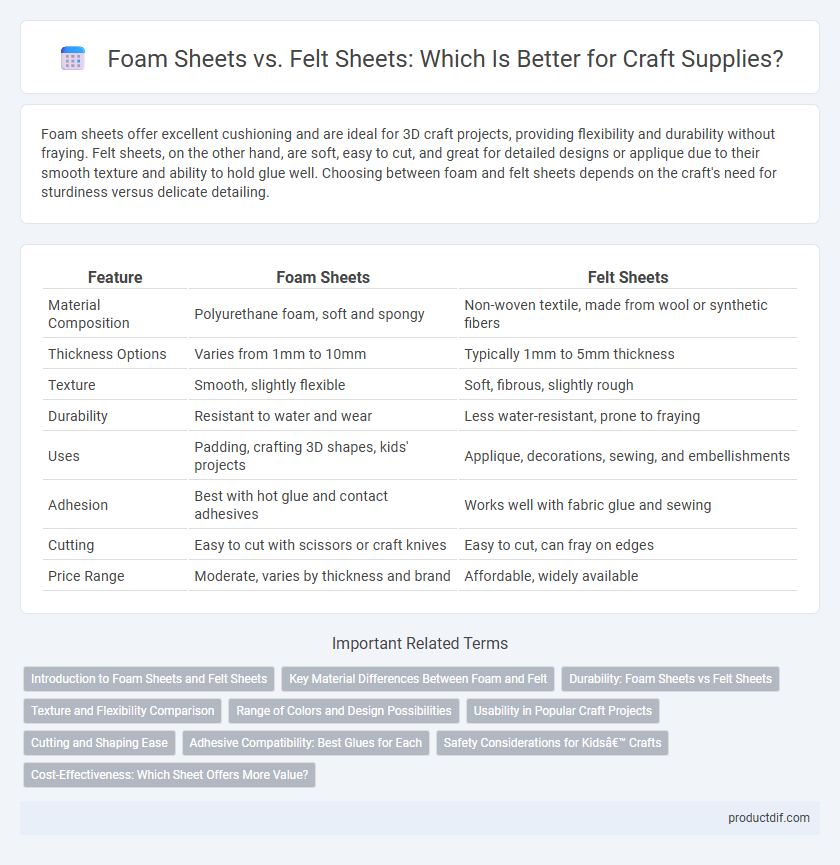Foam sheets offer excellent cushioning and are ideal for 3D craft projects, providing flexibility and durability without fraying. Felt sheets, on the other hand, are soft, easy to cut, and great for detailed designs or applique due to their smooth texture and ability to hold glue well. Choosing between foam and felt sheets depends on the craft's need for sturdiness versus delicate detailing.
Table of Comparison
| Feature | Foam Sheets | Felt Sheets |
|---|---|---|
| Material Composition | Polyurethane foam, soft and spongy | Non-woven textile, made from wool or synthetic fibers |
| Thickness Options | Varies from 1mm to 10mm | Typically 1mm to 5mm thickness |
| Texture | Smooth, slightly flexible | Soft, fibrous, slightly rough |
| Durability | Resistant to water and wear | Less water-resistant, prone to fraying |
| Uses | Padding, crafting 3D shapes, kids' projects | Applique, decorations, sewing, and embellishments |
| Adhesion | Best with hot glue and contact adhesives | Works well with fabric glue and sewing |
| Cutting | Easy to cut with scissors or craft knives | Easy to cut, can fray on edges |
| Price Range | Moderate, varies by thickness and brand | Affordable, widely available |
Introduction to Foam Sheets and Felt Sheets
Foam sheets are lightweight, flexible materials made from polyurethane or EVA, commonly used in crafting for their cushioning properties and ease of cutting. Felt sheets consist of dense, non-woven fabric typically made from wool or synthetic fibers, valued for their texture, durability, and vibrant color options. Both materials serve diverse crafting needs, with foam offering spongy support and felt providing a soft, sturdy surface.
Key Material Differences Between Foam and Felt
Foam sheets are made from synthetic polymers like polyurethane, offering a flexible, spongy texture and excellent cushioning properties, whereas felt sheets are composed of compressed fibers such as wool or synthetic blends, providing a dense, soft surface ideal for padding or decoration. Foam excels in shock absorption and moisture resistance, making it suitable for protective packaging and craft modeling, while felt's fibrous structure enables easy cutting, sewing, and adhesion for detailed applique or fabric embellishments. These material differences significantly influence their durability, flexibility, and application versatility in various craft projects.
Durability: Foam Sheets vs Felt Sheets
Foam sheets offer superior durability compared to felt sheets due to their resistance to tearing, moisture, and deformation, making them ideal for long-lasting craft projects. Felt sheets, while softer and more flexible, tend to wear out faster and are prone to fraying and absorbing liquids, reducing their lifespan in heavy-use applications. Choosing foam sheets enhances project longevity and structural integrity, especially in environments requiring frequent handling or moisture exposure.
Texture and Flexibility Comparison
Foam sheets feature a spongy, lightweight texture with high flexibility, making them ideal for three-dimensional crafts and cushion-like projects. Felt sheets offer a dense, soft texture that provides moderate flexibility, suitable for detailed designs and fabric-like applications. The choice between foam and felt sheets hinges on the desired tactile feel and the level of pliability required for the craft project.
Range of Colors and Design Possibilities
Foam sheets offer a vibrant range of bright and bold colors, making them ideal for projects that require striking visual impact and easy cutting for 3D designs. Felt sheets provide a softer, more muted color palette with a textured surface that enhances tactile design possibilities and layering effects. Both materials support versatile craft applications, but foam excels in durability and dimension while felt shines in intricate applique and embroidery work.
Usability in Popular Craft Projects
Foam sheets offer lightweight, flexible material ideal for 3D modeling, children's crafts, and cosplay accessories due to their easy cutting and shaping properties. Felt sheets provide a soft texture, perfect for sewing projects, applique, and decorative accents, as they hold stitches well and resist fraying. Both materials excel in versatility, but foam is favored for structural elements while felt is preferred in textile-based designs.
Cutting and Shaping Ease
Foam sheets offer superior cutting and shaping ease due to their lightweight, spongy texture, allowing precise cuts with scissors or craft knives and flexible molding into various shapes. Felt sheets, being denser and fibrous, require more effort to cut cleanly and maintain shape, often needing sharp tools to prevent fraying. For intricate or curved designs, foam sheets provide smoother edges and greater adaptability compared to felt sheets.
Adhesive Compatibility: Best Glues for Each
Foam sheets bond best with contact cement, hot glue, and spray adhesives due to their porous and flexible surface, ensuring a strong hold without damaging the material. Felt sheets perform well with white craft glue, fabric glue, and tacky glue, which provide a firm yet gentle bond to their fibrous texture while maintaining softness. Choosing the right adhesive enhances durability and appearance in foam or felt craft projects.
Safety Considerations for Kids’ Crafts
Foam sheets are non-toxic, lightweight, and generally safer for kids as they reduce the risk of cuts and are often BPA-free. Felt sheets, while soft and natural, may shed fibers that can cause irritation or choking hazards for younger children. Choosing foam sheets with certified safety standards like ASTM or EN71 ensures a safer crafting experience for children.
Cost-Effectiveness: Which Sheet Offers More Value?
Foam sheets generally provide more cost-effectiveness for bulk crafting projects due to their lower price per square foot and durability against wear and tear. Felt sheets, while slightly more expensive, offer superior versatility and aesthetic appeal for detailed projects that require texture and color variety. Evaluating the specific crafting needs and budget constraints will determine which sheet offers better overall value.
Foam sheets vs Felt sheets Infographic

 productdif.com
productdif.com